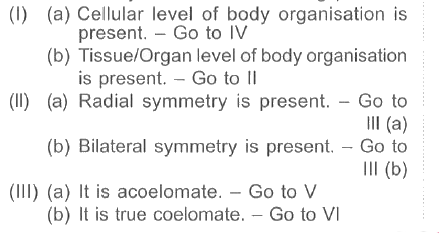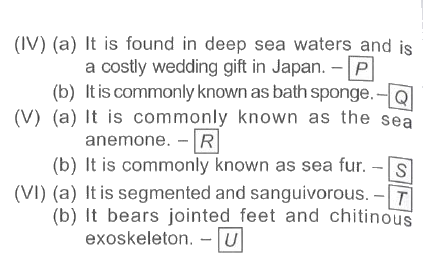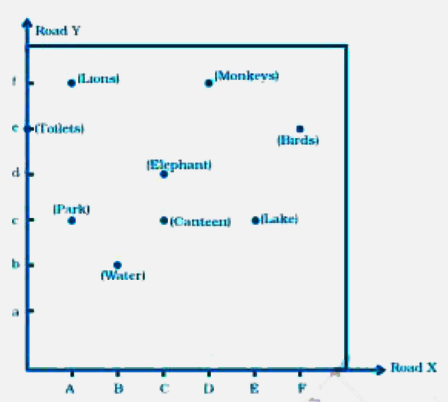Refer to the given dichotomous key and answer the following questions.


Which of the following statements is correct regarding the given dichotomous key?
The body of organism P is perforated by numerous pores called ostia whereas R possesses special stinging cells called cnidoblasts.
The excretory system of Q consists of characteristic flame cells or protonephridia. The body wall of S consists of special stinging cells called choanocytes whereas body of T is differentiated into head, visceral mass and foot.
Body of U bears paired locomotory appendages called parapodia.
The correct Answer is:A
Excretion in Spongia occurs through body surface, i.e., plasma membrane. Bodywall of Obelia (S) is lined by cnidoblast cells and body of molluscs is differentiated into head, visceral mass and foot. Periplaneta bears jointed appendages.
Topper's Solved these Questions
- DIVERSITY IN LIVING ORGANISMS BOOK - SCIENCE OLYMPIAD FOUNDATION CHAPTER - DIVERSITY IN LIVING ORGANISMS EXERCISE - ACHIEVERS SECTION (HOTS)
5 Videos
- CLASS 9 SAMPLE PAPER FINAL 4BOOK - SCIENCE OLYMPIAD FOUNDATION CHAPTER - CLASS 9 SAMPLE PAPER FINAL 4EXERCISE - SCIENCE
2 Videos
- IMPROVEMENT IN FOOD RESOURCES BOOK - SCIENCE OLYMPIAD FOUNDATION CHAPTER - IMPROVEMENT IN FOOD RESOURCES EXERCISE - ACHIEVERS SECTION (HOTS)
5 Videos
Similar Questions
Knowledge Check
Refer to the given figure and answer the following questions

Which of the following statement is correct?APart marked as P is present in all prokaryotes and eukaryotes.BBoth the parts P and Q are present in animal cells.CPlant cells lack the part marked as S.DPart marked as R is selectively permeable in both prokaryotes and eukaryotes.Refer to the given graph carefully and answer the following question.

Which of the labelled parts on the graph represents rigor mortis?AXBWCZDYRefer to the given keys and answer the following question.
P. membranes surrounding vacuoles
Q. shelves produced by the folding of inner mitochondrial membrane
R. stacks of membrane bound discs with chlorophyll and carotenoids
S. develops between two adjacent plant cells
Which of the following is not correctly matched?ACristae-QBMiddle lamella-SCGrana-RDPlasmodesmata-P
Study the diagram given below and answer the following questions.

View SolutionAnswer the following questions using the data given
View SolutionRefer the following data table and answer the following question.

If 400 calories are burnt by jogging 5 km, how many calories were burnt in the given week?
View SolutionRefer the following data table and answer the following question.

If 400 calories are burnt by jogging 5 km, how many calories were burnt in the given week?
View SolutionRefer the following data table and answer the following question.

Expenditure on raw materials and taxes is what percent of total expenses?
View Solution



